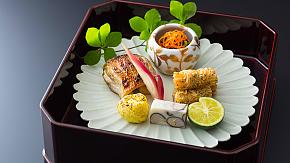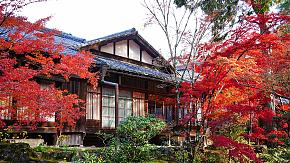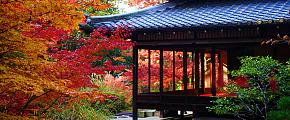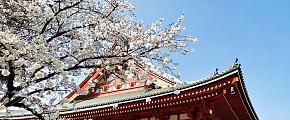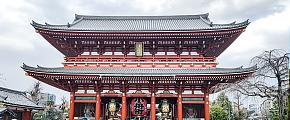Take Your Time: Visit the Best Places in Tokyo
Tokyo, where cutting-edge modernity, ancient buildings, and traditional culture sit side by side like nowhere else, is one of the strangest yet most wonderful cities you can visit. A trip to Japan can be a way to get a little closer while enjoying its indisputable beauty and variety. This time, we will spend time in and around the best places to visit in Tokyo, with attractions and activities like no other await.
- Tokyo's Best Places for Temples & Shrines
- Tokyo's Best Places for Street Food Culture
- Tokyo's Best Places for Animation Fun
- Tokyo's Best Places for Cherry Blossom Hanami
- Tokyo's Best Places for Colorful Fall Foliage
- Tokyo's Best Places for Street Fashion & Trend
- Tokyo's Best Places for Vivid Nightlife
- Tokyo's Best Places for Shopping
Tokyo's Best Places for Temples & Shrines
Sensoji Temple
Senso-ji is one of Japan's oldest and most significant Buddhist temples, and the scene of Japan's most important festival, Sanja Matsuri. It's bustling with visitors who come to make wishes, often tossing 5 yen coins into the offertory box before praying. For a more peaceful experience, consider visiting in the evening, when the temple is quieter and beautifully illuminated, creating a serene and almost mystical atmosphere.
 Senso-ji, Asakusa, Tokyo
Senso-ji, Asakusa, Tokyo
Meiji Shrine
Set in an evergreen forest, this is a shrine dedicated to Emperor Meiji and his wife, both of whom are regarded as gods by Japanese followers of the Shinto religion. It includes a museum with royal treasures and picture gallery documenting the life of the emperor Meiji and his family, and the Meiji Memorial Hall (Meiji Kinenkan), where you can witness a special Shinto wedding.
Tokyo's Best Places for Street Food Culture
Tsukiji Outer Market
Renowned as a fish market offering the freshest seafood, it's also a food paradise where you can savor the authentic flavors of Tokyo. From ready-to-eat sushi made with market-fresh ingredients to bite-sized sweet egg rolls, it's perfect for a brunch-time stroll that delights both your curiosity and your taste buds. Another good news is that the market opens at 5 am, when you can even witness the daily fish auction from the floor above. So go along if you can't sleep due to jet lag!
Nakamise Shopping Street
As you pass through the iconic Thunder Gate (Kaminarimon) with its massive red lantern towering about 4 meters high, you'll find yourself on the bustling Nakamise Shopping Street. This 250-meter-long, centuries-old avenue is lined with small shops offering souvenirs and local snacks, ranging from candy apples to sweet dango (rice dumplings), a perfect spot to enjoy some treats while strolling toward the main temple for your prayer.
Tokyo's Best Places for Animation Fun
Akihabara
Akihabara is the ultimate destination for Otaku culture and electronics, a haven for fans of video games, anime, and manga. You might enjoy visiting one of the many maid cafes, where you can sip coffee, indulge in desserts, or order omelet rice adorned with your favorite character's artwork. Keep in mind that photography is usually prohibited inside these cafes, though some may allow you to pose for a photo with "your maid" for a small fee.
 Akihabara, Tokyo
Akihabara, Tokyo
Ghibli Museum
A greenery-covered building with a maze-like entry, which is a true gateway to the fancy world created by Hayao Miyazaki, one of the best places to visit in Tokyo for anime fans to capture the life-size Totoro, Cat Bus, and Laputian Robot Trooper, as well as the room where the films were born, offering an immersive experience with an original anime films, a themed cafe and a reading room to jump in.
Tokyo's Best Places for Cherry Blossom Hanami
Shinjuku Gyoen
A delicate garden blends with French and Japanese architecture, a city oasis best for a relaxing drop-by. It is the scene location of the anime film The Garden of Words, also home to various cherry blossom species, Shinjuku Gyoen has a fairly long flowery period to enjoy the sakura blossoms from February to May, as well as a relatively quiet environment to immerse yourself in the spring colors.
Ueno Park
Dotted with 1000 cherry trees, Ueno Park is one of the most popular places for the spring hanami in Tokyo, a beloved spot for a leisurely flower-filled picnic with bento boxes, beer, and sake to share with family and friends. If there is much time for your linger, the surrounding galleries, museums, and popular Ueno Zoo are also worth a visit, making it an ideal choice for family outings.
Imperial Palace East Garden
The Imperial Palace is situated within a moated and walled park near the city center. While the eastern gardens are open to the public free of charge, they remain a favorite peaceful attraction, showcasing thousands of artworks and various species of cherry trees. During cherry blossom season, it's a popular spot for a leisurely stroll or a serene boat ride along the Chidorigafuchi moat.
Tokyo's Best Places for Colorful Fall Foliage
Yoyogi Park
An ideal stopover while exploring Shibuya or after praying at the Meiji Shrine, the lush Yoyogi Park offers an escape to encounter nature and local life. Of course, there are a few sakura trees to herald the arrival of spring, but the vibrant colors of the ginkgo and maple forests are far more appealing, perfect for taking a walk on the crisp autumn leaves or hiring a bicycle to capture the peaceful melody of instrumentalists.
Meiji Jingu Gaien
If you are planning to visit Meiji Shrine in autumn, here is an easy sightseeing route to try. Start at the Meiji Jingu Gaien, the outer garden, where rows of towering ginkgo trees glow in stunning shades of gold, covering the boulevard in a soft, fur-like carpet. Enjoy a relaxing stroll with a soothing crunch underfoot and conclude your journey at the iconic green Torii Gate, which leads to the main shrine building, completing an unforgettable autumn experience.
Tokyo's Best Places for Street Fashion & Trend
Shibuya
The birthplace of many youth fashion and entertainment trends, Shibuya is a bustling and colorful district characterized by its chaotic yet organized scramble across the street. There is no shortage of hip cafes and shops where you can try something new with a refreshing look and taste, such as Shibuya 109, a haven for modern fashionistas, or the unique taste of wrestler meals prepared by former sumo wrestlers.
 Shibuya, Tokyo
Shibuya, Tokyo
Harajuku
It is a place that demonstrates the meaning of "get lost in Tokyo", a lively yet unique district that stands out for its variety of colors and free-spirited fashion. In Harajuku, it is common to see passers-by in bright pink, delicate Lolitas in beautiful patterns, or elegant Goths with surprising make-up. Even the street food here is quite "over the top" - giant rainbow-colored cotton candy or crepes stuffed with various ingredients.
Tokyo's Best Places for Vivid Nightlife
Shinjuku
Shinjuku is the area centered on the world's busiest train station, Shinjuku Station, and is one of Tokyo's main commercial districts, bustling with shopping malls, bars, cafes, and restaurants whose neo-lights since never end, a true entertainment paradise for your special nightlife, whether head to the sleepless town Kabukicho for your bar and Karaoke hopping or the traditional taste with a kabuki show.
 Night View in Tokyo
Night View in Tokyo
Harmonica Yokocho
A narrow street lined with tiny restaurants, izakaya bars, and street food vendors, it is a great place to sample the local flavors of Tokyo, with freshly prepared food popular with locals for dinner or late-night snacks. Grab an outdoor seat or a window table, order some yakitori (grilled chicken) or sushi with a glass of sake (Japanese wine), and enjoy your meal as the city's night lights glow.
Tokyo's Best Places for Shopping
Ginza
Ginza is perhaps the most famous shopping district in Tokyo. Home to all the international big-name fashion and luxury goods stores, from branded bags to luxury jewelry, as well as smaller boutiques, department stores, and restaurants at its backstreets for an unexcepting adventure. Luxury dining at Michelin-starred restaurant, stroll through cutting-edge a gallery to capture those inspiring modern art, or pick a weekend when its main street turns into a pedestrian paradise to enjoy your endless shop.
 Ginza, Tokyo
Ginza, Tokyo
Roppongi
Not very far from Ginza, Roppongi is another upmarket neighborhood for your relaxing shopping experience, also bustling with luxury brands, fantastic arts, and culture offerings, as well as the unpretentious fun in '100-yen shop', offering a mix of ultra-luxury and great bargains. Roppongi is best for your nighttime wandering with its stunning illumination, especially during the festival season like Christmas and New Year.
Enjoy the Best Places to Visit in Tokyo
So, this has been a brief guide to Japan's always-fascinating city Tokyo, but of course, there is much more to this destination. If you wish to visit Tokyo and the rest of Japan, contact us at [email protected] with the requirements for your dream trip, and we'll get back to you with a personal, custom-made itinerary based on your ideas and wishes.
Quick Question
What Our Clients Say
Explore the latest verified reviews of Odynovo's travel services on Tripadvisor, Google, Trustpilot, Product Review and more trusted platforms.
SUBSCRIBE TO WIN A FREE TOUR
Subscribe to our newsletter for a chance to win a free 7-day tour to India! And more insider travel news, exclusive offers, and inspiration will be sent straight to your inbox. Check our previous newsletters and get some sparks.

